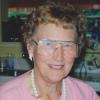
Inger Ricci was interviewed by David Krupa on July 20, 1993 at her home in Anchorage, Alaska. Her husband Charles was also present. The Ricci's interests in backcountry hiking and Alaska history have converged in the hobby of using metal detectors to search for historical artifacts, and their enthusiasm for the "hunt" was contagious. A recent journey along the old Valdez Trail, used by the stampeders in 1898, produced a number of interesting artifacts discarded or lost by the early pioneers. The Ricci's generally donate the materials they find to local museums. In this interview, Inger fondly recalled her experiences as a child, and growing up as the daughter of the master carpenter at Kennecott during its heyday in the 1920s. Her memories help form a picture of an isolated, yet very happy, community that was a children's paradise. She talks about the fullness of her life there, a feeling shared by other "Kennecott Kids" who, in the summer of 1991, gathered again at McCarthy and Kennecott to reminisce about their life at this unique mining community. Inger talks about the love for the area that people felt, and of her grief when the mine closed in 1938, shortly after she and her husband had returned in hopes of raising a family there. She also talks about the joys of seeing her childhood friends at the reunion, which was remarkably well-attended given the fact that many had not been back to Alaska - let alone Kennecott - in over one half century.
Digital Asset Information
Project: Wrangell-St.Elias National Park
Date of Interview: Jul 20, 1993
Narrator(s): Inger Jensen Ricci
Interviewer(s): David Krupa
People Present: Charles Ricci
After clicking play, click on a section to navigate the audio or video clip.
Sections
1) Inger's parents
2) Inger's background
3) First recollections of Kennecott
4) Childhood recreation and playing at Kennecott
5) The tramway and education at Kennecott
6) Religious services, ethnicity, and class distinctions
7) McCarthy, and appreciating Kennecott
8) Illnesses and the hospital
9) Domestic animal use
10) Supplies and transportation methods
11) Accidents, subsistence, chores, and hobbies
12) Local politics, and McCarthy
13) Guides in McCarthy
14) Holidays and special friends
15) High school education in Seattle
16) Nationality and holidays
17) Miners, residential life, and demographics
18) Wildlife, and alcohol
19) Law enforcement
20) Personal background and the closing of Kennecott Mine
21) Returning to Kennecott
22) Entertainment at Kennecott
23) Life after the mine closed and transportation between McCarthy and Kennecott
24) Kennecott Kids Reunion
27) The National Park Service at Kennecott
Click play, then use Sections or Transcript to navigate the interview.
After clicking play, click a section of the transcript to navigate the audio or video clip.
Transcript
Section 1: parents -- from Denmark\ Seattle -- where father "jumped ship"\ father -- freighting\ parents -- meeting and marriage\ Chilkat
Section 2: Kennecott -- Inger and brother born here\ brother -- died in Denmark for a visit
Section 3: school -- 1st thru 8th grade\ teachers -- new one each year\ Kennecott marriage policy
Section 4: facilities -- skating rink\ facilities -- community hall\ skiing\ hiking\ family\ children\ groups -- "the Yard Gang"
Section 5: tram -- women rarely allowed to ride\ education -- children in Kennecott
Section 6: Cordova\ church -- Sunday school\ ethnic diversity\ Scandinavians\ Germans\ people -- class distinction\ social -- dances\ Kennecott -- Silk Stocking Row (named in 1950's)
Section 7: McCarthy\ ice cream\ alcohol
Section 8: Seattle -- for hospital\ California\ illness\ Kennecott -- hospital treated anyone in area; reasonable prices
Section 9: animals -- work dogs\ McCarthy\ animals -- horses
Section 10: Kennecott -- order supplies from store\ Cross, John -- pilot from King Salmon\ Gillam\ Smith, "Mud Hole"\ Christensen, Chris\ transportation -- train\ transportation -- one automobile in Kennecott
Section 11: accidents\ subsistence\ father\ mother\ garden\ childhood -- tomboy; chores\ library
Section 12: local politics\ McCarthy -- few families\ railroad\ trapping\ guides
Section 13: guides\ Boyden, Harry\ Maloy, Joe\ Slimpert, Billy
Section 14: holidays -- Christmas\ Kennecott Mine -- provided extras for workers\ Duggan, Mary Ellen and Peggy\ Vickery, Deborah and Jane\ Konnerups -- 3 children
Section 15: education -- high school in Seattle
Section 16: holidays -- July 4th and Christmas\ holidays -- games and dances
Section 17: bunkhouse\ gambling -- poker\ population -- approximately 300 people in Kennecott (camp -- 1000 workers at mines)
Section 18: wildlife -- bears\ wildlife -- grouse\ food -- berries\ alcohol -- home brewed wine and beer during Prohibition
Section 19: law -- law enforcement\ McCarthy -- red light district
Section 20: Seattle\ education -- business college\ marriage\ Watsjold, Oscar -- husband\ Kennecott Mine -- closing of
Section 21: Kennecott -- returning to\ McCarthy\ transportation -- trains
Section 22: entertainment -- movies\ entertainment -- ball game\ entertainment -- dating
Section 23: Cordova, AK\ Seward, AK\ Spiderro, Frank\ McCarthy\ transportation -- little "speeder"
Section 24: Kirkwood, Richard\ organization -- contacted each other to inform of reunion\ reunion -- (occurs every four years '94, '98, and '02) occurred 1990 summer in Kennecott\ Kennecott Mine -- "Mother Lode" mine\ Donahoe Peak\ tours -- glacier walks\ Bean -- family\ reunion -- unique quality of\ reunion -- demography of participants\ Alaska\ Anchorage\ Lower 48
Section 27: National Park Service -- cable car and no bridge\ buildings -- preservation of

